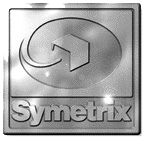
by Jerry Vigil
 How are you processing your voice tracks? Do you run your mic through a compressor/limiter and make EQ adjustments at the console? Do you also run the mic through a multi-effects box to apply a noise gate? This is a pretty common setup for a lot of producers, unless you’re fortunate enough to have a voice processor. They eliminate patching from box to box, and they keep the signal path short and noise free by putting everything in one neat little package, the kind of package Symetrix is well known for. You’ve probably seen their 528 in a studio somewhere (maybe your own), and you may recall a Test Drive [November 1993 RAP] on the 601, a monster digital voice processor that also included a bank of delay and modulation effects. The new 628 Digital Voice Processor from Symetrix is a beautiful combination of the two, taking the 528 up to the digital level with some nice features, and bringing the 628 down to a less complex and more affordable unit. The 628 packs a pre-amp, de-esser, expander/gate, compressor, and parametric equalizer in a single rack-space unit. At the top of its list of features is the ability to store settings to one of 119 user preset locations, a major plus for any studio that records many voice talents.
How are you processing your voice tracks? Do you run your mic through a compressor/limiter and make EQ adjustments at the console? Do you also run the mic through a multi-effects box to apply a noise gate? This is a pretty common setup for a lot of producers, unless you’re fortunate enough to have a voice processor. They eliminate patching from box to box, and they keep the signal path short and noise free by putting everything in one neat little package, the kind of package Symetrix is well known for. You’ve probably seen their 528 in a studio somewhere (maybe your own), and you may recall a Test Drive [November 1993 RAP] on the 601, a monster digital voice processor that also included a bank of delay and modulation effects. The new 628 Digital Voice Processor from Symetrix is a beautiful combination of the two, taking the 528 up to the digital level with some nice features, and bringing the 628 down to a less complex and more affordable unit. The 628 packs a pre-amp, de-esser, expander/gate, compressor, and parametric equalizer in a single rack-space unit. At the top of its list of features is the ability to store settings to one of 119 user preset locations, a major plus for any studio that records many voice talents.
Rear panel connections include balanced XLR mic and line inputs as well as a balanced TRS 1/4-inch line level input. You can only use one or the other, mic or line input. The PHANTOM POWER On/Off switch accommodates both dynamic and condenser type microphones. You’d expect a single output from this single channel processor, but the 628 offers two balanced line level XLR outputs labeled Analog Left and Analog Right. There is no stereo processing taking place; the output at both connectors is the same. In effect, you have a second output that can be used simultaneously with the first should you have a need to split the output. One use for the second XLR output might be to set it to mic level (with an internal jumper). That way the box is capable of being connected to either the line or mic input of the console. Nice flexibility. And if you need unbalanced line level outputs, there are two 1/4-inch outputs next to the XLR outs.
This is a digital processor, and you’ll also find digital outputs on the rear panel. You get AES/EBU on an XLR connector and S/PDIF on RCA. The DIGITAL OUTPUT SELECT button chooses between the two, and the SAMPLE RATE SELECT switch selects between 32kHz, 44.1kHz, and 48kHz sampling. The MIDI/RC-1 IN and MIDI OUT/THRU jacks do not provide MIDI control of parameters. These connectors are used to perform MIDI dumps of preset information from one 628 to another. The MIDI/RC-1 IN also accepts the optional RC-1 Remote Controller, a very handy device that provides instant switching between the unit’s first 11 presets. The RC-1 is basically a MIDI controller that sends only eleven program change commands and can be used to access the first eleven programs on any MIDI capable box. A twelfth button sets the 628 to bypass mode. The RC-1 gets its power from the 628 via the special cable provided, but a 9V DC input on the back of the RC-1 accepts an external power source for using the RC-1 with units other than the 628. The MIDI CHANNEL SELECT switch (1-16), MIDI PROGRAM DUMP button, and the AC Power connector wrap up the rear panel tour.
The 528 user will feel right at home with the 628’s front panel which divides the various components of the processor into separate sections. At the far left is the Mic Pre-Amp section. The MIC/LINE button switches between mic and line level inputs. Another button activates a 15dB pad to accommodate mics with high output. The GAIN control adjusts the mic level input from +15dB to +75dB and the line level input from -12dB to +12dB. A red CLIP LED lights when the pre-amp is overloaded. The analog input is sent to a 20-bit A/D converter, and the digital signal is sent to 24-bit processing for the effects.

